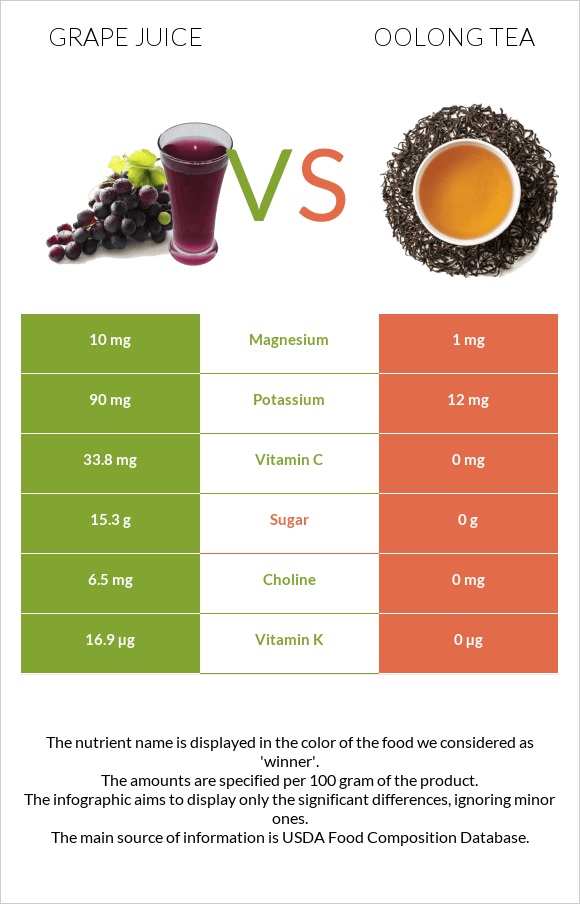Grape juice vs. Oolong tea — In-Depth Nutrition Comparison
Compare
How are grape juice and oolong tea different?
- Grape juice is higher in vitamin C and vitamin K; however, oolong tea is richer in manganese.
- Daily need coverage for vitamin C for grape juice is 38% higher.
- Oolong tea has less sugar.
- Oolong tea has a lower glycemic index (0) than grape juice (63).
Babyfood, grape juice, no sugar, canned and Beverages, tea, Oolong, brewed are the varieties used in this article.
Infographic

Infographic link
Mineral Comparison
Mineral comparison score is based on the number of minerals by which one or the other food is richer. The "coverage" charts below show how much of the daily needs can be covered by 300 grams of the food.
| Contains more MagnesiumMagnesium | +900% |
| Contains more CalciumCalcium | +1100% |
| Contains more PotassiumPotassium | +650% |
| Contains more IronIron | +∞% |
| Contains more CopperCopper | +∞% |
| Contains more ZincZinc | +400% |
| Contains more PhosphorusPhosphorus | +1000% |
| Contains more SeleniumSelenium | +∞% |
| Contains less SodiumSodium | -70% |
| Contains more ManganeseManganese | +213.4% |
Vitamin Comparison
Vitamin comparison score is based on the number of vitamins by which one or the other food is richer. The "coverage" charts below show how much of the daily needs can be covered by 300 grams of the food.
| Contains more Vitamin CVitamin C | +∞% |
| Contains more Vitamin AVitamin A | +∞% |
| Contains more Vitamin B1Vitamin B1 | +∞% |
| Contains more Vitamin B2Vitamin B2 | +∞% |
| Contains more Vitamin B3Vitamin B3 | +233.3% |
| Contains more Vitamin B6Vitamin B6 | +∞% |
| Contains more Vitamin KVitamin K | +∞% |
| Contains more FolateFolate | +∞% |
All nutrients comparison - raw data values
| Nutrient |  |
 |
DV% diff. |
| Vitamin C | 33.8mg | 0mg | 38% |
| Vitamin K | 16.9µg | 0µg | 14% |
| Manganese | 0.067mg | 0.21mg | 6% |
| Carbs | 15.38g | 0.15g | 5% |
| Vitamin B6 | 0.06mg | 0mg | 5% |
| Iron | 0.3mg | 0mg | 4% |
| Caffeine | 0mg | 16mg | 4% |
| Calories | 62kcal | 1kcal | 3% |
| Copper | 0.028mg | 0mg | 3% |
| Magnesium | 10mg | 1mg | 2% |
| Potassium | 90mg | 12mg | 2% |
| Vitamin B2 | 0.02mg | 0mg | 2% |
| Calcium | 12mg | 1mg | 1% |
| Phosphorus | 11mg | 1mg | 1% |
| Vitamin B1 | 0.01mg | 0mg | 1% |
| Vitamin B3 | 0.2mg | 0.06mg | 1% |
| Folate | 4µg | 0µg | 1% |
| Choline | 6.5mg | 0mg | 1% |
| Net carbs | 15.38g | 0.15g | N/A |
| Sugar | 15.3g | 0g | N/A |
| Zinc | 0.05mg | 0.01mg | 0% |
| Sodium | 10mg | 3mg | 0% |
| Vitamin A | 4µg | 0µg | 0% |
| Selenium | 0.1µg | 0µg | 0% |
| Threonine | 0.024mg | 0% | |
| Isoleucine | 0.007mg | 0% | |
| Leucine | 0.017mg | 0% | |
| Lysine | 0.019mg | 0% | |
| Methionine | 0.029mg | 0% | |
| Phenylalanine | 0.017mg | 0% | |
| Valine | 0.024mg | 0% | |
| Histidine | 0.031mg | 0% |
Macronutrient Comparison
Macronutrient breakdown side-by-side comparison
Protein:
0 g
Fats:
0 g
Carbs:
15.38 g
Water:
84.4 g
Other:
0.22 g
Protein:
0 g
Fats:
0 g
Carbs:
0.15 g
Water:
99.84 g
Other:
0.01 g
| Contains more CarbsCarbs | +10153.3% |
| Contains more OtherOther | +2100% |
| Contains more WaterWater | +18.3% |
~equal in
Protein
~0g
~equal in
Fats
~0g





